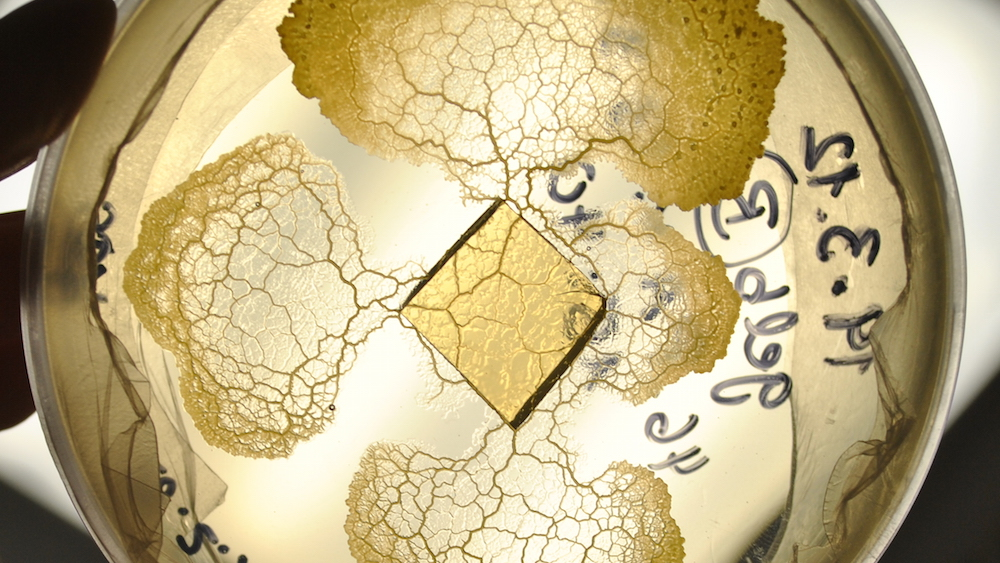Physarum polycephalum is a unicellular multinucleated slime mold that can grow up to hundreds, in special circumstances even thousands of square centimeters in size. Physarum forms extended networks in order to search for and connect food sources.
Slime molds

What is a slime mold?

Foraging behavior
The nutrients taken up are transported along tubes via shuttle streaming, an oscillatory mechanism organizing as a peristaltic wave. Although Physarum polycephalum does not have a nervous system in the conventional sense, it is able to adjust its structure and foraging behavior as a response to complex challenges.
Key aspects
Satellites
Generally, Physarum grows into a tubular network in order to forage. However, under starvation conditions, Physarumproduces small fragments, satellites, that move away radially from the point of inoculation. Since this alternative growth progression, termed a search pattern, was observed under starvation conditions, satellites are likely an emergency mechanism of Physarum for survival. To this end, a scaling analysis has been performed to describe the search pattern based on the assumption that Physarum will maximize the area surveyed by satellites.
Oscillations
The oscillations of micro- and macroplasmodia alike are based on the interaction of actin and myosin. We monitor microplasmodia dynamics by observing area oscillations with bright-field microscopy whereby the spatio-temporal dynamics of focal area and contour can be analyzed. Fast oscillations with a period of 1-2 min as well as several superimposed slow oscillations can be found.
Networks
Network theory is vital for the understanding of many real-world systems, such as the vascular system, which is difficult to study in vivo. P. polycephalum is a suitable model organism because it is easy to manipulate. Thus, we strive to understand the dynamics of the vast networks, which originate from accreting microplasmodia. When small amoebae are placed in clusters upon an agar surface, they will crawl around and eventually fuse to form a larger network, which then grows from a few microns to several centimetres, again forming a veinous macroplasmodium. We study the topological phase transition from single microplasmodia into an elaborate network applying graph theory. Function of the network is found to be closely tied to the emergence of structure.
Force measurements
For a detailed understanding of the fundamental processes of cell motility, it is necessary to investigate mechanical properties of the cell. Deformation occurs in response to physical forces, which can either come from the external environment or are intracellularly generated. By testing the reaction to an applied stress and recording the response, it is possible to gather insights into the mechanical properties of the actomyosin cytoskeleton of P. polycephalum. However, existing models mostly treat cells as a homogenous mass of cytoplasm, surrounded by a membrane. We investigated the ultrastructure of microplasmodia using transmission electron microscopy (TEM) and scanning electron microscopy and found a porous, sponge-like internal structure with elaborate channels, connected to the surface via pores. This channel system reacts different to deformation than a homogenous mass of cytoplasm and has to be taken into account when assessing the force measurements.
Slime mold videos
Ist dieser Schleimpilz Intelligent? by Doktor Whatson
More slime mold videos
Slime mold and young scientists

Jugend Forscht: contest for young researchers
We support regularly young interested researchers in the Jugend Forscht competition:
- Mit dem Schleimpilz auf Siegertreppchen, C. Markwort, Weser Kurier, 06.03.2017
- Bremer Schleimpilze für Paderborn, J. Tiedemann, Weser Kurier, 05.03.2016
- Schüler forschen mit Schleimpilzen zum Thema Mobilität, N. Fritzsche, Weser Kurier, 07.05.2015
- Integrated biology of Physarum polycephalum: cell biology, biophysics, and behavior of plasmodial networks C Oettmeier, A Fessel, HG Döbereiner, Myxomycetes, 453-49
- Adaptive behaviour and learning in slime moulds: the role of oscillations A Boussard, A Fessel, C Oettmeier, L Briard, HG Döbereiner, A Dussutour, Philosophical Transactions of the Royal Society B 376 (1820), 20190757
- Slime mold on the rise: the physics of Physarum polycephalum Christina Oettmeier, Toshiyuki Nakagaki, Hans-Günther Döbereiner, Journal of Physics D: Applied Physics 53 (31), 310201, 2020
- Mitochondrial numbers increase during glucose deprivation in the slime mold Physarum polycephalum Christina Oettmeier, Hans-Günther Döbereiner - Protoplasma 256 (6), 1647-1655, 2019
- A lumped parameter model of endoplasm flow in Physarum polycephalum explains migration and polarization-induced asymmetry during the onset of locomotion Christina Oettmeier, Hans-Günther Döbereiner - PloS one 14 (4), 2019
Media coverage
- Faszinierende Parallelen zum menschlichen Gehirn, K. Hermann, Welt der Physik, 22.05.2020
- Wie von einem anderen Stern, Naturwald Akademie, 26.05.2020
- Contribution in a documentary The Blob: A Geninus without a Brain directed by Jacques Mitch, Hauteville Productions, 2019
- YouTube Video in cooperation with Doktor Whatson Ist dieser Schleimpilz ohne Gehirn intelligent?
- Interview with Hans-Günther Döbereiner, Radio Corax: Die erstaunlichen Eigenschaften des Schleimpilzes Physarum polycephalum (26.06.2019)
- Radio feature on Myxomycetes (Slime molds), Deutschlandfunk Kultur: „Zeitfragen. Forschung und Gesellschaft“ (22.02.2018)


